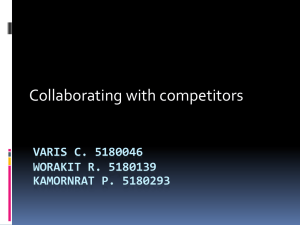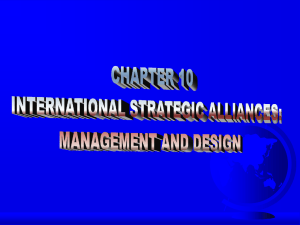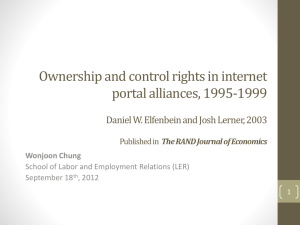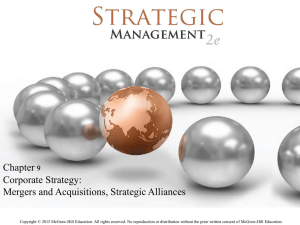Strategic Alliances
advertisement
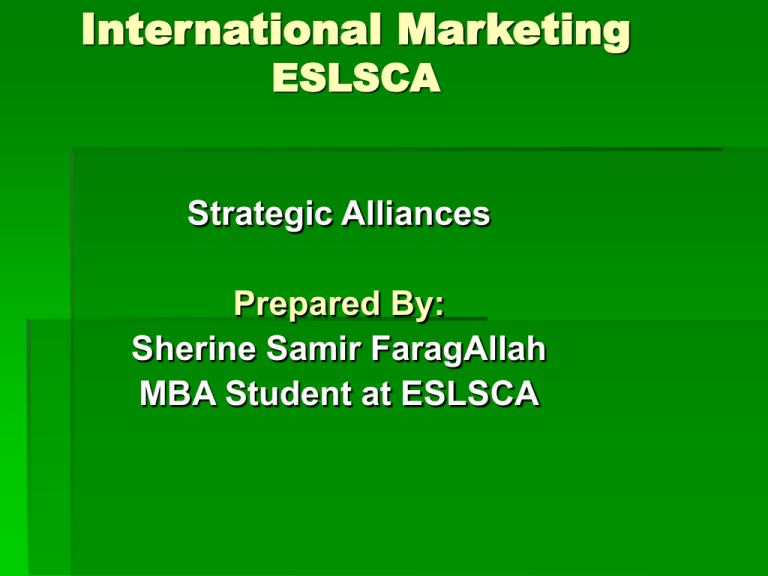
International Marketing ESLSCA Strategic Alliances Prepared By: Sherine Samir FaragAllah MBA Student at ESLSCA Agenda What is meant by Strategic Alliance? Purposes of Strategic Alliances Success Factors Mistakes Leading to Failure Types of Alliances Examples What is meant by Strategic Alliance? Definition 1: An agreement between two or more individuals or entities stating that the involved parties will act in a certain way in order to achieve a common goal. Strategic alliance usually make sense when the parties involved have Complementary strengths. Definition 2: Strategic alliances are innovative and interesting forms of relationships between organizations. Organizations create alliances in their quest to compete against fast & nimble competitors. What is Meant by Strategic Alliance? cont’d Definition 3: Strategic alliances are agreements between companies (partners) to reach objectives of a common interest. Alliances are among the various options which companies can use to achieve their goals. They are based on cooperation between companies. Purposes of Strategic Alliances Competition is shifting from a "firm versus firm perspective" to a "supply chain versus supply chain perspective." Therefore, firms seeking competitive advantage are participating in cooperative supply chain arrangements, such as strategic alliances, which combine their individual strengths & unique resources. Enabling a firm to focus resources on its core skills & competencies while acquiring other components or capabilities it lacks from the marketplace. Alliances can often improve market power of a firm because either the alliance partner is a customer for the product or because the distribution channels & buying power of the partners can be combined Purposes of Strategic Alliances cont’d Alliances enable buying & supplying firms to combine their individual strengths & work together to reduce non-value-adding activities & facilitate improved performance. In order for both parties to remain committed to this form of relationship, mutual benefit must exist (i.e. a "win-win" relationship) Success Factors Selection: Strategically evaluate which upstream & downstream members should be included in the supply chain to create a highly competitive & efficient supply network. Selecting strategic partner should be based on company’s goals, objectives & values system. Select partners who have competencies in collaboration & those who already have a proven ability to work in a collaborative environment. Intention: Both partners should acknowledge their mutual dependence & their willingness to work for the survival & prosperity of the relationship. Success Factors cont’d Trust: Existence of trust in a relationship reduces perception of risk associated with opportunistic behavior as this generates greater profits & serve customers better Communication: Communication is critical for building successful relationships to achieve the benefits of collaboration as it allows partners to understand alliance goals, roles, responsibilities & helps with the sharing & dissemination of individual experiences Conflict Resolution: Firms should be motivated to engage in joint problem solving as they are, by definition, linked together to manage an environment that was more uncertain & turbulent than each one could control. Success Factors cont’d Developing a focused winning strategy for the alliance: Based on distinctive competencies and competitive advantages of the partners in the selected target market (s). To ensure there will not be a goal divergence or conflict between alliance partners. To be able to manage the company cultural challenges that may arise between the alliance partners. Partners should be in vulnerable strategic positions: (i.e., in need of resources) or when they are in strong social positions (i.e., possess valuable resources to share). seeking complementary or similar resources for transferring or pooling. Progressive learning & value capturing: Learning involves significant transfer of tacit, specialized & complex knowledge. Learning requires close collaboration of both firms to overcome transfer challenges as knowledge, values, culture and organizational forms. Success Factors cont’d Respect and protect the brand of each partner. Determine and align decision rights: To define what decisions are important to the alliance, which partner should make them and how the decisions will be made and monitored. Exit Strategy: Agree upon an exit strategy for the alliance. It Is important to have agreement in advance on how the alliance will be concluded if and when it may fail and/or when it has fulfilled its mission and achieved its goals and objectives Mistakes Leading to Failure Alliance business is viewed internally by one partner. One of the partners is too dependant on the other’s capabilities. Problems and dilemmas of mistrust. Cultural & language barriers. Collaboration in competitively sensitive areas can be difficult. A clash of egos might occur. Types of Strategic Alliances Joint Venture: an agreement by two or more parties to form a single entity to undertake a certain project. Each of the businesses has an equity stake in the individual business and share revenues, expenses & profits. Outsourcing Global Strategic Alliances: working partnerships between companies (often more than 2) across national boundaries & increasingly across industries. Sometimes formed between company & a foreign government, or among companies & governments Types of Strategic Alliances cont’d Equity strategic alliance: an alliance in which 2 or more firms own different percentages of the company they have formed by combining some of their resources & capabilities to create a competitive advantage. Non- equity strategic alliance: an alliance in which 2 or more firms develop a contractualrelationship to share some of their unique resources & capabilities to create a competitive advantage. Types of Strategic Alliances cont’d Affiliate Marketing: exploded over recent years with the most successful online retailers using it to great effect. The nature of the internet means that referrals can be accurately tracked right through the order process. Amazon was the pioneer of affiliate marketing, and now has tens of thousands of websites promoting its products on a performance-based basis. Technology Licensing: a contractual arrangement whereby trade marks, intellectual property and trade secrets are licensed to an external firm. It’s used mainly as a low cost way to enter foreign markets. The main downside of licensing is the loss of control over the technology – as soon as it enters other hands the possibility of exploitation arises. Types of Strategic Alliances cont’d Distributors: Recruiingt distributors, where each one has its own geographical area or type of product. This ensures that each distributor’s success can be easily measured against other distributors. Distribution Relationships: This is perhaps the most common form of alliance. Strategic alliances are usually formed because the businesses involved want more customers. The result is that crosspromotion agreements are established. Product Licensing: This is similar to technology licensing except that the license provided is only to manufacture and sell a certain product. Usually each licensee will be given an exclusive geographic area to which they can sell to. It’s a lower-risk way of expanding the reach of your product compared to building your manufacturing base and distribution reach. Types of Strategic Alliances cont’d R&D: Strategic alliances based around R&D tend to fall into the joint venture category, where two or more businesses decide to embark on a research venture through forming a new entity. Franchising: is an excellent way of quickly rolling out a successful concept nationwide. Franchisees pay a set-up fee & agree to ongoing payments so the process is financially risk-free for the company. However, downsides do exist, particularly with the loss of control over how franchisees run their franchise. Examples of Alliances Nokia and Microsoft in alliance to make Zune phone Star Alliance – Airlines alliances. Philips and Sony jointly launched the mini-CD. Nestlé and Fonterra Sign Agreement on Dairy Alliance for the America McDonald’s with Disney, Coca-Cola & Walmart Online grocer Webvan Group forms alliances with foodmakers: Kellogg, Nestle, Pillsbury, Quaker Examples of Alliances cont’d Motorola-Toshiba: In 1987- Toshiba to produce microprocessors & contribute access to the distribution network. Boeing, General Dynamics & Lockeed in the early 90’s, these companies united to win a bid put forth by the Pentagon for the construction of a tactical combat destroyer. Alcatel –Fujistsu made a joint venture to develop the equipment for the third generation of cellular telephone Samsung & Sun Microsystems cooperated in solution business and next generation business computing system. THANK YOU


